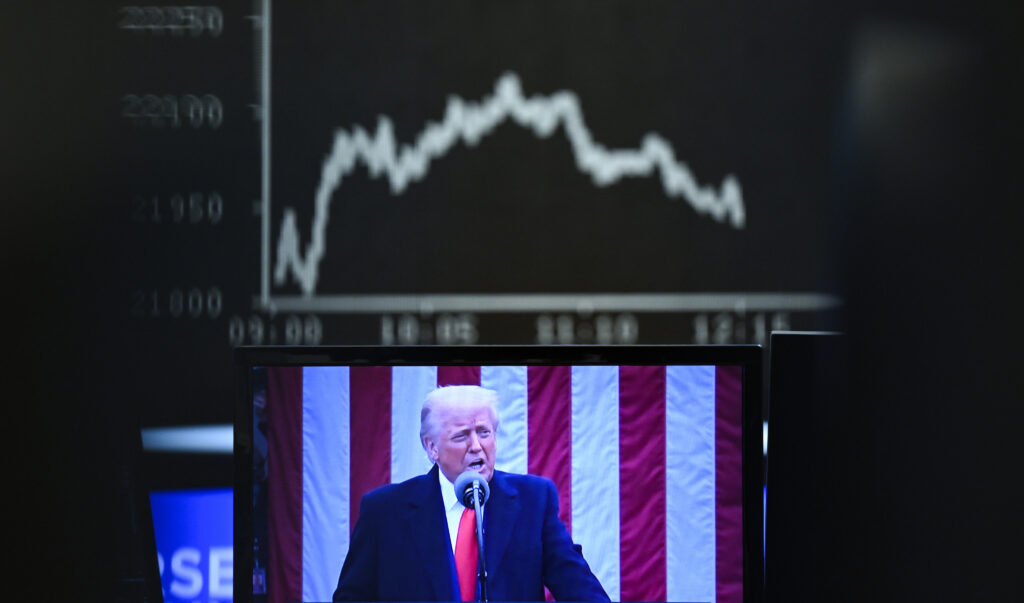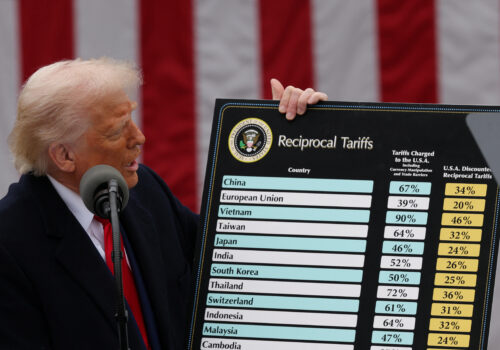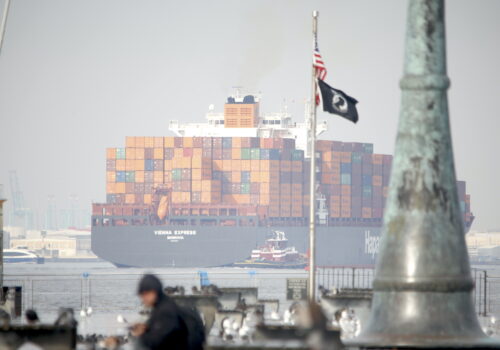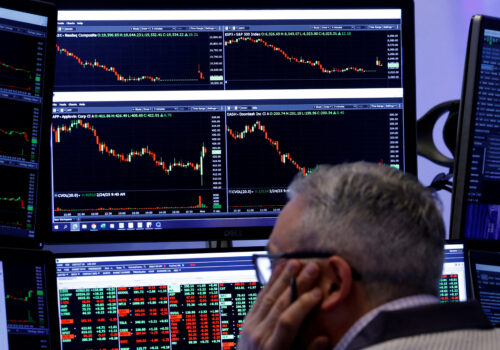The Department of Government Efficiency (DOGE) should have been their first clue.
Global investors’ repeated miscalculation of US President Donald Trump’s far-reaching intentions regarding tariffs has left them playing a chaotic game of catch-up. The result has been four trillion dollars in value wiped off the S&P 500 since its peak in February.
That was before the further losses that will come now, as investors come to terms with the president’s determination to undo an eighty-year era of globalization and replace it with, as today’s lead Wall Street Journal editorial put it, “Trump’s New Protectionist Age.”
Trump’s Rose Garden announcement Wednesday of “liberation day” tariffs of 10 percent on all foreign nations—with higher levies on many top trading partners—marks one of the most significant US economic policy moves in decades, perhaps the most dramatic shift since the protectionist-busting 1944 Bretton Woods agreement itself. If the plan goes into effect next week as scheduled, then it will result in the highest effective US tariff rate in a century.
It’s long past time to understand what’s driving the president—and what’s liberating him.
Here’s a short list of what most investors missed until recently:
- Trump’s approach in his second term, similar to the logic DOGE has brought to federal spending, is that the global trading system wasn’t working for the United States, couldn’t be reformed, and therefore needed to be broken. Short-term stock market pain would be an acceptable price for wholesale change.
- Drawing on the experience of Trump’s first term, investors expected Trump’s tariffs to be primarily a tactic to negotiate better trade deals, which still might be the case regarding China. But overall, Trump’s new tariffs appear instead to be aimed, over the short term, at bringing in more federal revenue to offset tax cut renewals. Over the longer term, the US president said he wants tariffs to encourage companies to reshore manufacturing and other businesses, creating jobs and generating corporate taxes. To complicate matters further, Trump is also using some tariffs as punishment, like sanctions, against countries for reasons that range from not controlling immigration to failing to stop fentanyl trafficking.
- Investors also overlooked the liberating impact on Trump’s freedom of decision through a new set of advisers who are more likely to encourage than to second guess him. During Trump’s first term, Treasury Secretary Steven Mnuchin and National Economic Council Director Gary Cohn seem to have acted as a brake on Trump’s tariff passions. Today, however, Treasury Secretary Scott Bessent and National Economic Council Director Kevin Hassett appear to play more of a background role to trade advisor Peter Navarro and Commerce Secretary Howard Lutnick, who encourage the president’s course.
- Global investors were thinking incrementally, calculating how best to trade on each day’s news, instead of recognizing the president’s audacious ambitions. “Assuming the policy sticks—and we hope it doesn’t,” wrote the Wall Street Journal editorial board, “the effort amounts to an attempt to remake the US economy and the world trading system.”
Investors are not the only ones who have taken note. World leaders are reeling from Trump’s actions, and more than a few are concluding that the president, intentionally or not, could undo all the good that the Bretton Woods agreement did against the rampant protectionism that preceded World War II.
As Josh Lipsky, senior director of the Atlantic Council GeoEconomics Center, told me, “The protectionism of the 1930s led to rival trade blocks, which unfortunately only ended with the calamity of war and the creation of the Bretton Woods system. Not to overstate the stakes, because we need to see what happens and how countries respond after Wednesday’s announcements, but the risks of miscalculation and escalation are high.”
The Trump administration is betting that countries won’t retaliate because it is not in their economic interest, given the massive economic leverage of the US economy. After a period of disruption, the Trump administration is calculating that its tariff approach will lead to the greater stability of a fairer trading system with benefits for the US economy and the American worker.
To encourage foreign partners not to retaliate and escalate, Bessent said this week that the new tariffs would be a ceiling, from which they could be lowered over time. “One of the messages that I’d like to get out tonight,” Bessent told CNN on Wednesday, “is everybody sit back, take a deep breath, don’t immediately retaliate, let’s see where this goes. Because if you retaliate, that’s how we get escalation.”
Other countries aren’t buying this message that the United States is starting at a ceiling, and some will likely retaliate both for economic and for domestic political reasons. “The US certainly has economic leverage,” said Lipsky. “But countries are looking at where they can hurt the US in ways not commonly thought of in a trade war. They’ve had six years to think about this.”
So, watch China go after US tech companies, and watch the European Union go after tech and services, where the United States has a considerable surplus.
With Wednesday’s announcement by Trump, the world is returning to pre-World War II protectionism—but at a time when the United States is much more exposed than it was then to the global economy. Imports today are nearly 15 percent of US gross domestic product, compared to only 5 percent then.
History’s lessons are clear. Trade wars are costly and nobody wins. Trump has a habit of confounding critics, so there’s always a risk in betting against him. That said, global investors did just that today, driving markets down, chastened by the mistakes they’ve made thus far in underestimating how far the president was determined to go.
One sign of this has been how the US dollar fell against most other currencies in Asian and European markets today. The WSJ Dollar Index, which is based on a basket of global currencies, is down 5 percent this year and below where it was before Trump’s November 2024 election. Some investors argue that “US economic aggression against allies is eroding the dollar’s ‘global reserve’ status,” explained the Wall Street Journal’s Jon Sindreu.
Trump called Wednesday’s tariff announcement “our declaration of economic independence.”
World leaders and investors can continue to ignore the president’s revolutionary intentions if they’d like, but it will be at their own ever-growing expense.
Frederick Kempe is president and chief executive officer of the Atlantic Council. You can follow him on X: @FredKempe.
This edition is part of Frederick Kempe’s Inflection Points newsletter, a column of dispatches from a world in transition. To receive this newsletter throughout the week, sign up here.
Further reading
Wed, Apr 2, 2025
How Trump’s ‘liberation day’ tariffs will transform global trade
Fast Thinking By
Our experts share their insights on how US President Donald Trump’s sweeping tariffs will impact US trade partnerships and the global economy.
Tue, Feb 4, 2025
Where do the Trump tariffs go from here?
Fast Thinking By
US tariffs on China went into effect today, while President Donald Trump paused levies on Mexico and Canada. Our experts explain who and what could be next.
Tue, Mar 4, 2025
A Wall Street wake-up call on Trump’s tariffs
Fast Thinking By
As markets fall in response to the US decision to increase the cost of importing goods from Canada, Mexico, and China, how is the US president thinking about tariffs?
Image: Behind a television monitor showing US President Donald Trump, the display board with the Dax curve shows falling share prices. The tariff package announced by US President Trump has pushed share prices sharply into negative territory. Arne Dedert/dpa via Reuters Connect





